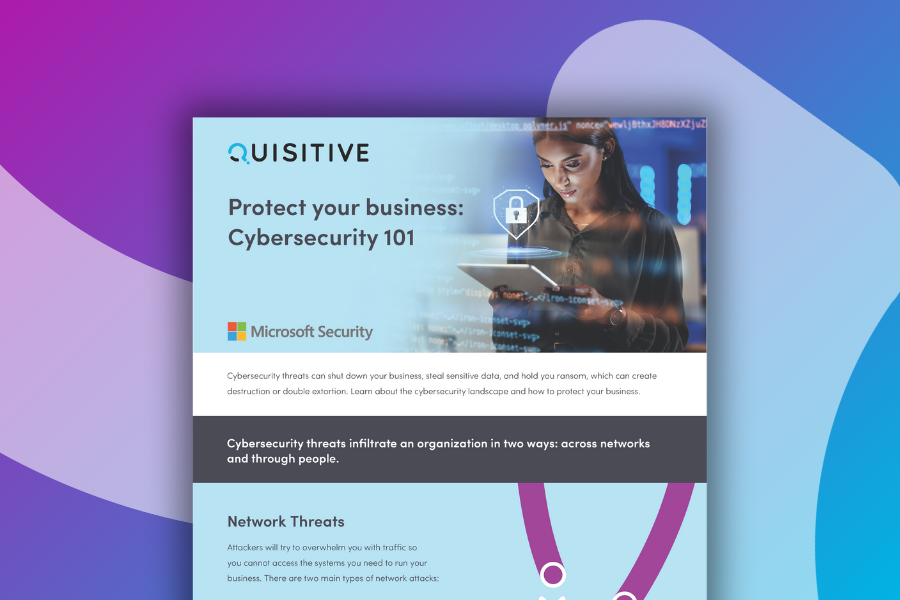Your public cloud is publicly accessible. Let that sink in.
The move to the cloud unlocked incredible business potential, but it also threw the old playbook for network security out the window. Suddenly, your network perimeter isn’t a tidy line around your office building. It’s a sprawling, dynamic environment managed through APIs on platforms like Amazon Web Services (AWS) and Microsoft Azure. For small and mid-sized businesses, this shift can be daunting.
Don’t worry. Securing your cloud environment isn’t about having a Fort Knox-sized budget. It’s about being innovative, strategic, and consistent.
Here are 10 real-world cloud network security best practices, backed by industry standards, to lock down your cloud and protect your business.
1. Actually Enforce “Least Privilege” (IAM)
We often discuss the Principle of Least Privilege, yet it tends to be overlooked when we’re in a hurry. Identity and Access Management (IAM) is the first and most crucial line of defense against security threats. One common issue leading to data breaches is the use of overly permissive roles.
Actionable Takeaway:
Avoid using root or global administrator accounts for everyday tasks. In Azure, Microsoft Entra ID (formerly known as Azure AD) can be utilized to create custom roles that provide just enough access through Role-Based Access Control (RBAC). For example, you can create a Billing Reader role that allows users to view costs in Azure Cost Management without granting permission to modify any resources. This way, if credentials are compromised, the potential impact is limited.
2. Segment Your Network
Don’t put all your digital assets into a single container. In Azure, a Virtual Network (VNet) allows you to create logically isolated areas within your cloud environment. This concept is fundamental to building a secure network security architecture.
Actionable Takeaway:
Create separate VNets for your development, testing, and production environments. Network segmentation helps prevent mistakes or security breaches in non-production environments from affecting your customer-facing applications. For critical workloads, consider further dividing VNets into multiple subnets (e.g., one for web servers and one for databases) without direct internet access.
3. Use Network Security Groups as Micro-Firewalls
Every major cloud provider offers network firewalls, which in Azure are known as Network Security Groups (NSGs). NSGs are stateful firewalls that protect individual resources, such as virtual machines or the subnets in which they reside, by controlling the traffic allowed in and out.
Actionable Takeaway:
By default, NSG rules should deny all inbound traffic from the Internet. You should only open specific ports that your application needs to function. For example, if you are running a web server, you would typically create an inbound rule to allow traffic on port 443 (HTTPS) from any source. Additionally, you might set up another port 22 (SSH) rule that allows access only from a specific, trusted IP address range, such as your office. This simple configuration can significantly reduce the risk of automated attacks.
4. Encrypt Everything, Everywhere
Unencrypted data poses a significant risk of a data breach. To ensure data security, it’s essential to encrypt data both at rest (when stored on a disk) and in transit (when transmitted across a network).
Actionable Takeaway:
By default, Azure encrypts all data at rest using platform-managed keys. For greater control, you can use customer-managed keys securely stored in Azure Key Vault. To secure data in transit, implement Transport Layer Security (TLS) version 1.2 or higher for all traffic to your applications. According to the NIST Cybersecurity Framework, safeguarding data is fundamental to a robust security program.
5. Automate Your Guard Duty with CSPM
Manually checking hundreds of settings across multiple services is impractical. That’s where Cloud Security Posture Management (CSPM) tools come into play. These tools continuously scan your cloud environment for misconfigurations, comparing them against established benchmarks.
Actionable Takeaway:
Utilize the native CSPM tools provided by your cloud service provider. For example, in Azure, Microsoft Defender for Cloud is your command center. It offers a “Secure Score” that assesses your security posture and provides prioritized, actionable recommendations to address issues such as overly permissive network ports, missing encryption, and the absence of multifactor authentication (MFA).
6. Keep Your Systems Patched
The shared responsibility model is straightforward: Microsoft is responsible for securing the Azure infrastructure, while you are accountable for patching your guest operating systems and applications.
Actionable Takeaway:
Use Azure Automation Update Management to evaluate the patch status of your virtual machines and schedule recurring automated deployment windows. This will help ensure that critical vulnerabilities are addressed promptly without the need for manual intervention.
7. Turn On the Logs (and Actually Look at Them)
When something goes wrong, logs are the first place to look to understand what happened. If logging is not enabled, you’ll be left without any insights. Azure provides detailed logs for various activities, including user actions (Azure Monitor Activity Logs) and network traffic (NSG Flow Logs).
Actionable Takeaway:
Centralize all your critical logs in an Azure Log Analytics workspace. You don’t need to analyze them manually; instead, set up simple alert rules in Azure Monitor for high-risk events. This includes changes to critical NSG rules, global administrator logins from unusual locations, or the deletion of a Key Vault. If something goes wrong, logs are the first place you’ll look to figure out what happened. If they aren’t on, you’re flying blind. Azure generates powerful logs for everything from user activity (Azure Monitor Activity Logs) to network traffic (NSG Flow Logs).
Actionable Takeaway:
Funnel all your critical logs into a central Azure Log Analytics workspace. You don’t have to analyze them manually. Set up simple alert rules in Azure Monitor for high-risk events, such as changing a critical NSG rule, a global administrator login from an unusual location, or deleting a Key Vault.
8. Rethink Remote Access with Zero Trust
The era of relying on a single, trusted internal network with an unrestricted VPN is behind us. A Zero-Trust approach, as outlined in frameworks like NIST SP 800-207, emphasizes the principle of “never trust, always verify.” This means granting access to specific applications rather than providing access to the entire network.
Actionable Takeaway:
Instead of exposing RDP or SSH ports to the internet (even with Network Security Group rules), utilize Azure Bastion. This service enables secure and seamless RDP/SSH access to your virtual machines directly from the Azure portal over SSL, eliminating the need for a public IP address on your virtual machine.
9. Have a Plan for DDoS Attacks
Distributed Denial-of-Service (DDoS) attacks are designed to overwhelm applications with malicious traffic, causing them to go offline. The good news is that basic protection is built-in.
Actionable Takeaway:
Azure offers DDoS Protection Basic for free with all services, which safeguards the entire Azure infrastructure. For business-critical applications, consider upgrading to the DDoS Protection Standard. This upgrade provides adaptive tuning, detailed attack analytics, and cost protection against resource scaling during an attack.
10. Back up, Then Try to Break It
Backups are your ultimate safety net for data security, but a backup that hasn’t been tested is merely a hope, not a solid plan.
Actionable Takeaway:
I learned this lesson the hard way early in my career. I set up automated daily backups for a critical database using Azure Backup and felt confident in the process. However, six months later, when a minor server crash occurred, we needed to restore the data. Unfortunately, the backup policy was configured correctly, but a subtle permissions issue caused it to “fail silently” for a few key files, resulting in incomplete backups. We ended up spending a frantic weekend recovering data manually.
Now, I adhere to this important rule: schedule a quarterly “Recovery Drill.” Once a quarter, I restore a non-critical system from an Azure Backup vault to a test resource group to ensure that the entire process runs smoothly.
Recommended Resources for Cloud Network Security
If you want to explore further, the following resources offer excellent, in-depth guidance:
- Microsoft Azure Well-Architected Framework—Security Pillar: This is Microsoft’s official guidance outlining best practices for securing workloads in Azure.
- Center for Internet Security (CIS) Benchmarks are prescriptive, consensus-driven configuration guidelines designed to secure Azure and other cloud platforms.
- NIST Cybersecurity Framework (CSF): This is a voluntary framework, standards, and best practices to manage cybersecurity risk.
- NIST Special Publication 800-207: Zero Trust Architecture: A detailed guide to the core principles and implementation approaches for a Zero Trust security model.
So, You Think You’re Secure Now?
Now, it’s time to test that confidence. Please choose one of these ten best practices where you feel the weakest and dedicate two hours this Friday to implementing it. Remember, your cloud network security isn’t a one-time achievement; it’s an ongoing process. Alternatively, you can ignore it and see what happens. The choice is yours.
If you need help implementing an effective approach, Quisitive Spyglass Services, along with our Azure Managed Services, can optimize and efficiently manage your environment.

;)



